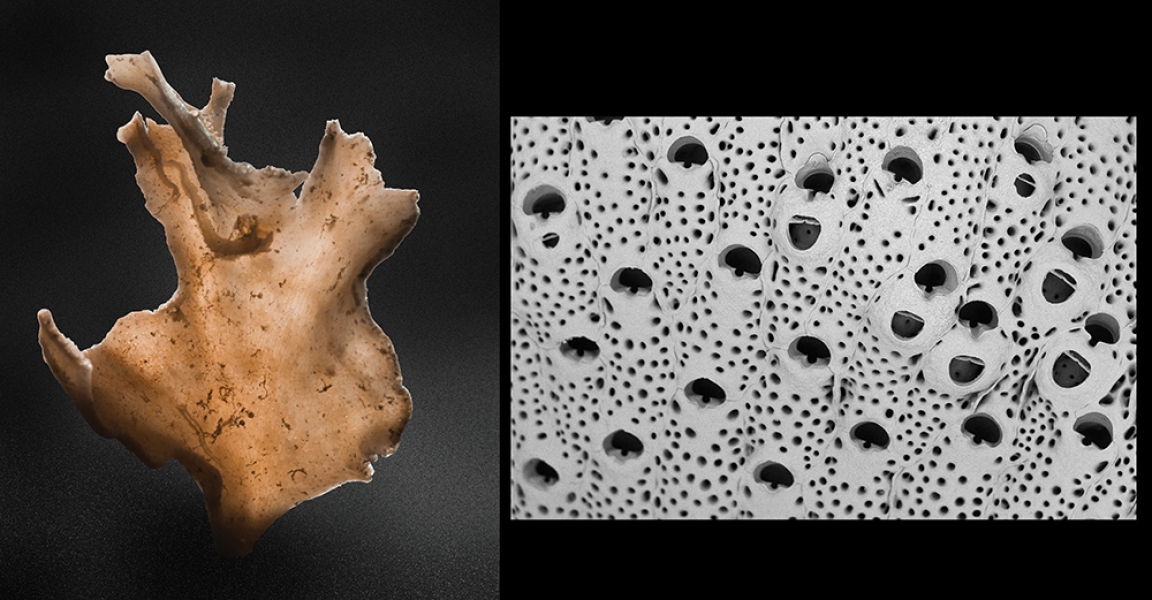This week’s critter will forever have a special link with NIWA CEO John Morgan. John received an extra special surprise at a recent NIWA staff event when he was handed a framed photo of a new species of bryozoan lace coral. In honour of John Morgan the new species had been named Bountyella morgani. It is not every day you get a species named after you!
All in a name
In a recent paper in the Journal of the Marine Biological Association of the United Kingdom, titled Apprehending novel biodiversity—fifteen new genera of Zealandian Bryozoa (Gordon 2014, download a copy here), NIWA Principal Scientist and world bryozoan expert, Dennis Gordon decided to honour John Morgan “in recognition of his appreciation of the value of taxonomic research”. John had been showcasing the achievements of the NIWA biosystematics group and collections team and commended their work by stating: “if we don’t conduct this work in New Zealand, no one will.”
New Zealand bryozoan diversity
The New Zealand region is incredibly rich when it comes to Bryozoa (one of the common names is lace corals), a diverse group of mostly small colonial organisms that are also well-represented in the fossil record. Dennis Gordon has been working on this group in New Zealand and around the world for a number of decades and thanks to his work, not NIWA, New Zealand (it’s across collections in other places as well) currently have records for nearly 1000 species in the New Zealand region alone. Incredibly, about a third of these species still need to be described, something that Dennis hopes to complete over the next few years.
But wait, there is more to come!
In the chapter of the New Zealand Inventory of Biodiversity (Gordon et al. 2009) the authors estimate that at least another 300 species remain to be discovered throughout the region. Moreover, 61% of the species so far known are endemic to New Zealand, i.e. don’t occur anywhere else outside the region, which makes our little part of the world an important biogeographic region and a hotspot of bryozoan diversity worldwide.
In Dennis’ most recent paper, he sets the scene for a more comprehensive description of many of our species by establishing fifteen new genera which have been collected from shallow coastal waters to the deep sea.
Despite the fact that bryozoans are usually relatively small (usually around 10 – 30 cm tall and the largest known to grow to more than 1 m tall), they are important habitat formers in some regions which provide shelter, perch and substrate for many other organisms.
If you are interested in New Zealand Bryozoa, here is a concise field guide to the bryozoans of southern New Zealand with a general introduction to Bryozoa.
Bountyella morgani
This species was at the point of publication only known from the type locality near the Bounty Islands, at 113 m depth. However more samples have since been recorded from near Kaikoura and The Snares islands. Dennis describes it as an erect, somewhat curled colony morphology which is large enough to form a potential microhabitat. He notes that one of the specimens has tubeworms growing on it.
References:
Gordon D.P., Taylor P.D. and Bigey F.P. (2009). Phylum Bryozoa–moss animals, sea mats, lace corals. In Gordon D.P. (ed.) New Zealand inventory of biodiversity, volume one. Kingdom Animalia: Radiata, Lophotrochozoa, Deuterostomia. Christchurch: Canterbury University Press, pp. 271–297.
Gordon D.P. (2014). Apprehending novel biodiversity—fifteen new genera of Zealandian Bryozoa. Journal of the Marine Biological Association of the United Kingdom. Volume 94 (08): 1597-1628.


